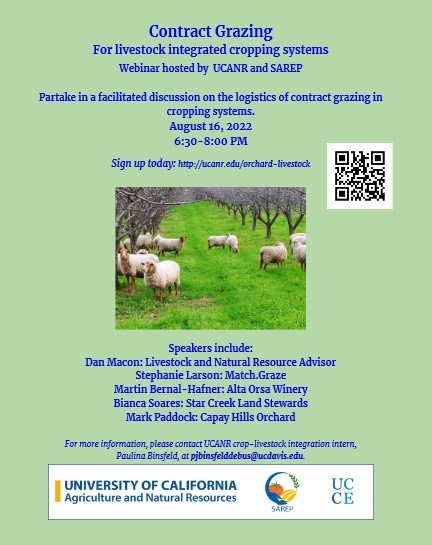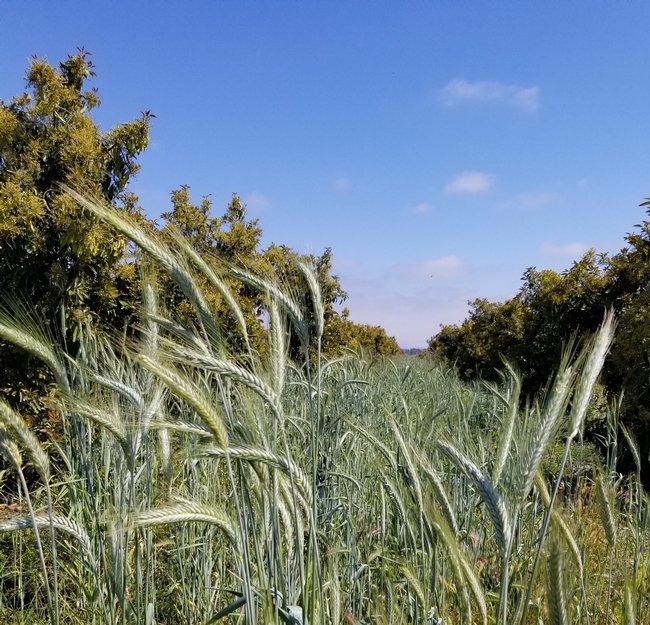
Posts Tagged: cover crops
Sheep Grazing in Vineyards and Fields

Vineyard grazing flyer (002)
Cowpeas Can Make Money in Spanish Mandarins
If you can sell your cowpeas, fava beans and barley, you can make money in Spain and apparently not use any more water than if just growing the mandarins. And coastal growers should look at the fresh market. Have you ever tasted a fresh green cowpea or fava bean? Pretty darn good and consumers think so, as well.
A Diverfarming project study compares the environmental footprint and the economic performance of traditional mandarin monocropping as opposed to growing mandarin intercropped with herbaceous crops and the use of deficit irrigation
The transformation towards intensive agriculture has led to agricultural practices in Europe that have centred on increasing the yield and reducing costs in recent decades, and which involve a major dependence on external sources of agrochemicals and energy. These intensive monocropping systems have generated biodiversity losses, water contamination, and high rates of greenhouse gas emissions, as well as degrading the soil and reducing the ecosystem services.
Faced with this situation, the European Diverfarming project has trialled the diversification of crops throughout the European Union, seeking the best practices to combine crops and focusing on reducing inputs to find the best options to preserve the sustainability of the systems and increase the resilience of the European agricultural sector. To do so, it is also necessary to know the impacts of these practices both at environmental as well as economic level.
With the aim of knowing the environmental footprint and the economic performance of the introduction of herbaceous crops among the alleys of the mandarin trees using controlled deficit irrigation in a mandarin grove located in the Region of Murcia, a team of researchers from the Universidad Politécnica de Cartagena have carried out a life-cycle assessment of the crop and an evaluation of the costs and income of the farm for the three years that the experiment in this case study was carried out.
Although the growing area increased with the introduction of the herbaceous crops (in this case purslane, cowpea, broad beans, and a barley-vetch mix), no detrimental effects occurred in terms of exhausting resources, acidification, or global warming. Therefore, the practice of intercropping did not cause additional contamination or other environmental impacts. This, in addition to the results of the increase in nitrogen and organic carbon content and in the soil and the reduction in erosion and run-off makes the introduction of herbaceous crops in the alleys of the mandarin trees a good sustainable environmental option to cope with the current challenges of the sector.
In economic terms, the financial security of the agricultural community also becomes a key element for successfully adopting diversified systems. This study highlights, through the economic assessment, that intercropping can lead to an increase in production costs, mostly related with a greater demand for labour in comparison with monocropping. However, the study also concludes that “the correct choice of intercropping practices can bring economic advantages”. The results showed that the mandarin crop with purslane and broad beans as intercrops could be profitable and reduce the risk for the grower against volatile prices in the main crop.
In this way, considering all the potential environmental and economic benefits of intercropping practices, these systems arise as a tool to move towards more sustainable and profitable agricultural systems. The valorisation of agricultural products that are more respectful to the environment on the part of consumers and the backing of public funding (e.g., direct help to growers who introduce intercropping) are key aspects to drive the adoption of these practices.

pixie harvest 2
Avocados and Cover Crops
Alli Rowe-Fish and Ben Faber
Cover crops offer an important opportunity to build soil health in avocado orchards. A cover crop is a crop seeded or encouraged as natural plant cover as an investment in soil fertility and not as a cash crop. Most cover crops are grasses, legumes, brassicas or a mixture and serve to protect bare soil while improving soil physical, chemical, and biological properties.
Benefits of cover crops
Perennial systems, trees in the ground for long periods of time, are unable to harness the benefits of crop rotation that include improved nutrient cycling, soil tilth, soil physical properties, weed and pest suppression, and erosion control. By cycling cover crops, growers of tree crops can mimic crop rotation on a portion of the land surface and maximize benefits in an orchard system.
The benefits of cover crops in California avocado orchards include:
- Improved soil structure;
- Reduced soil compaction;
- Reduced soil erosion from wind and rain;
- Increased soil organic matter content;
- Improved nutrient cycling;
- Weed suppression;
- Creation of habitat for pollinators and beneficial insects;
- Improved water infiltration
- Improved soil moisture storage
- Increased soil aeration
- Disease suppression.
California will continue to experience increased intensity and duration of drought and heat stress days. These environmental conditions dramatically impact fruit set and viable production of avocados. Improving soil health builds resiliency to climatic conditions and allows farmers to continue to grow in the face of climate change. A specific consideration is improved water infiltration achieved by cover cropping in orchards. The enhancement in soil structure due to the presence of varying depths of roots allows for precipitation to infiltrate rather than run off. By keeping precious precipitation on the orchard property, growers become more resilient in the face of drought and heat. Improved infiltration by rain water can improve salt leaching and reduce salt stress on the tree.
Selecting a cover crop
The main consideration in selecting a cover crop is to identify the purpose and objectives for its use. Table 1 identifies specific goals and considerations for cover cropping. Most avocado growers in California will opt for a winter cover crop to harness winter rains to avoid irrigating. Therefore, the following selections are geared towards winter cover crops and do not go into detail for summer cover cropping.
Cover crop mixes may be more expensive than single species covers such as only a brome or a medic, but satisfy multiple purposes in one planting and often see successful establishment and growth rates. They may provide better cover, weed suppression, and biomass, especially during drought or other non-optimal growing conditions. In addition, mixes supply multiple nutrients and benefits beyond a single species. For example, a mix that includes triticale, faba bean, and daikon radish sees the benefit of soil stabilization and infiltration from all three species, increased carbon content from the triticale, nitrogen fixation from the faba bean, and reduced soil compaction from the radish.
In selecting a cover crop, it is critical to consider any pests that may be encouraged with certain species. For example, many avocado growers are constantly battling gophers in young orchards. Gophers love clover varieties, so if you already have more gophers than you can handle, consider choosing a cover crop mix that does not contain clovers. There does not appear to be an increase of ground squirrel activity with covers (https://digitalcommons.unl.edu/cgi/viewcontent.cgi?article=1020&context=vpc17).
Table 1. Cover Crop Categories and Considerations
Seeding timing
The timing of cover crop seeding will vary based on location and operational goals. However, flexibility is key for getting cover crops seeded at the right time to maximize winter rainfall for good establishment. Many cover crop seed companies will recommend seeding in fall, October or November. In Central and Southern California, that time frame tends to be hot, dry, and windy – not ideal conditions to seed a cover crop. The best time to seed would be right after the first rains come to loosen the soil and provide a bit of moisture. The key to success lies in watching the weather and being able to jump on a window between early rain events.
Frost can be a consideration for many avocado growers in Central and Southern California. Early establishment of tall cover crops can increase risk of frost exposure and should be avoided. To get around frost issues, seeding later in the fall and early winter can delay growth of the cover crop until the frost prone days have passed. This may mean seeding in early January to ensure minimal growth during January and February when frost may be a concern. As the weather warms in March, cover crops can take off and build biomass without posing a risk to tree health.
Termination strategies
Winter cover crops are generally terminated nearing the last rainfall events so they do not compete with trees for irrigation water. Termination strategies vary based on type of cover crop and availability of equipment. Cover crops can be terminated by mowing, tillage/disking, grazing, or simply allowing them to dry up if they are low growing. Leaving cover crop residue on the surface protects the soil from wind erosion, acts as a natural mulch to suppress weed seedlings, and releases nutrients to the soil as it decomposes. The downside to leaving residue on the surface is the retention of moisture which could provide habitat for slugs and snails. Incorporating cover crop residue immediately after termination speeds up the decomposition time, increasing nutrient release into the soil. This should only be considered in young or=chards where root damage would not occur due to incorporation. This, however, requires the right equipment and relatively flat terrain, which is not representative of most California avocado operations. Grazing is an effective termination strategy to remove high biomass cover crops. However, it is important to consider GAP and NOP food safety regulations by ensuring animals are not in the orchard within 90 days of harvest.
Triticale and Lamb Hass
Walking the Avocado Area of Cal Poly SLO
Virtual Avocado Field Day 2021
Zooming to Healthier Trees and Soils
April 14, 2021 (1 - 3pm)
Presented in partnership with the California Avocado Society, Inc.,
California Avocado Commission, and UC Cooperative Extension
as part of the California Avocado Growers Seminar Series
and the CDFA Healthy Soils Program
Speakers
Pruning strategies for optimum yield and quality
Gabriel Filipe, Sr Director of CA Sourcing and Farming, Mission Produce
Trialing new rootstock varieties
Lauren Garner, Professor of Horticulture, Cal Poly San Luis Obispo
Scouting for pests and updates on biological pest control
David Headrick, Professor of Entomology, Cal Poly San Luis Obispo
Building berms for hillside orchards
Johnny Rosecrans, Sr Farm Technician, Cal Poly San Luis Obispo
Cover crops and soil health
Charlotte Decock, Asst Professor of Soil Science, Cal Poly San Luis Obispo
Moderators
Ben Faber, Soils/Water/Subtropical Crops Advisor, UC Cooperative Extension
Claire Balint, Interim Director, Cal Poly Center for Sustainability
Special thanks to the Brock Center for Agricultural Communication
Video recordings will be available on this website after the virtual live event
For questions, please email cfs@calpoly.edu

avocado fruit
Cover Crop Selector
New to cover crops? What alternatives are there and how does one figure out what might work in your special situation? Well, be one of the first to test out a new software program developed by Shulamit Shroder, our Climate Smart Specialist in Kern County. She would love to get feed back on how it works and can be improved.
https://ucanr.edu/blogs/blogcore/postdetail.cfm?postnum=41426
How many different cover crops can you count in this photo?

cover crop trial 8-30-2019 2



